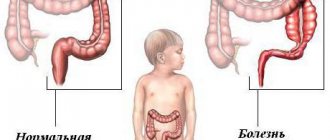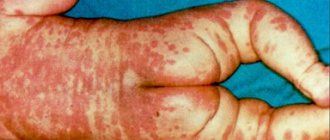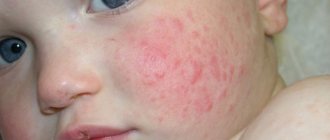A common disease of immune origin, manifested as inflammation of the walls of the capillaries of the skin and internal organs, is hemorrhagic vasculitis. This is an aseptic pathology, which is characterized by the active formation of immune complexes and damage to the wall of microvessels with an increase in their permeability. The disease is systemic in nature and affects people at any age, but the largest number of patients are among children and adolescents aged 4 to 12 years. Boys get sick 2-2.5 times more often than girls.
What kind of disease is this
This disease is of an infectious-allergic nature: the main cause of hemorrhagic vasculitis is the presence in the blood of patients of immune complexes and active components of the protective system of proteolytic enzymes. Immune complexes accumulate in the bloodstream, and with an excessive amount of antigens or a lack of antibodies, protein formations are deposited on the endothelium of the microvascular wall. Factors contributing to the development of the disease are:
- bacterial and viral respiratory infections suffered 2-4 weeks before the onset of the disease, which account for up to 60-80% of all cases of the disease;
- foci of chronic infection (sinusitis, tonsillitis, caries, etc.);
- some medications, mainly of antibiotic action;
- potentially allergenic foods (strawberries, citrus fruits, chocolate, eggs, etc.);
- administration of a vaccine or serum;
- hypothermia and dampness or prolonged exposure to the sun.
There is evidence of a hereditary predisposition to the disease. In some cases, it is impossible to find out which factor served as the “trigger” for the patient’s body.
Clinic
The totality of manifestations of Henoch-Schönlein disease can be divided into several forms:
- lightning;
- acute;
- subacute;
- chronic.
Each of the forms can have its own degree of flow:
- high;
- moderate;
- minimal.
- The acute form is characterized by the following symptoms: a sharp rise in temperature, which will last for several days, then can be reduced, general weakness, joint pain, abdominal pain, and a bright rash.
- The fulminant form is characterized by the following symptoms: a sharp rise in temperature, fever, hemorrhages on the surface of the skin and mucous membrane; in the center of the points themselves, you can even observe such an irreversible process as tissue necrosis, and sometimes intestinal bleeding. The fulminant form is considered very dangerous, as it is often accompanied by renal failure, which ends in kidney damage. This form requires immediate medical attention as it can be fatal.
- The subacute form is characterized by the following symptoms: slow development of the disease, slow development of a rash, temperature within 37.5 degrees. All this can happen over several weeks and often becomes chronic.
- The chronic form is characterized by symptoms of a subacute form with repeated manifestations caused by one reason or another.
The classification of systemic vasculitis depends on the size of the vessel involved in the disease:
- vasculitis of medium-sized vessels;
- immune complex vasculitis of medium vessels;
- vasculitis of large vessels;
- associated vasculitis.
Articular/cutaneous-articular form of the disease
Reactive inflammation of the elbow, wrist, knee, ankle, joints (arthritis) has become a very common phenomenon that occurs in children. Most often this concerns the lower extremities, which are disrupted by swelling. The child also has a high temperature, skin and intra-articular rash, and his general condition worsens. The inflammatory process can be short-term, or it can be protracted, but the good news is that the complications of hemorrhagic vasculitis are reversible.
Abdominal (abdominal)/abdominal-cutaneous) form
Signs of this form, according to pediatrics, will be pain in the peritoneum, cramping in nature, a rise in temperature, rashes on the internal digestive organs and on the skin surface. Often the pain resembles appendicitis, causing weak stools and vomiting. This form is very dangerous, as it can be accompanied by bleeding of the digestive tract and peritonitis. The mild form of the disease lasts no more than four days.
Cutaneous form
The name speaks for itself: a rash on the skin is the main signs and symptoms of this form of Henoch-Schönlein disease. But the rash itself can be different - small, granular or larger, nodular. It is most often painted purple, but when pressed it turns pale. Often the specks are grouped and even merge with each other, thereby presenting a more vivid picture. The rash is most often localized on the extremities, as well as on the mucous membranes. The rash lasts for several days and may be accompanied by pyretic and sometimes hyperpyretic temperature. It does not disappear completely; it is replaced by skin pigmentation. If the specks were large, after they disappear, dead areas of skin and crusts appear. A skin rash can have different stages of development, but in fact the same consequences: itching of the skin, swelling of the mucous membranes, swelling and pain of the joints. Most often, the above symptoms occur in young children.
Kidney form
It is often the most severe, and as a result, in the worst case, kidney damage occurs. Accompanied by lack of appetite, weakness in the limbs, fever and swelling. Sometimes this form does not give any clinical results, thereby increasing the likelihood of chronic kidney disease.
Regardless of what symptoms appear to you, the first thing to do is contact a medical facility. There, tests will be taken from the child, based on the results of which treatment will be prescribed; the increase in the number of leukocytes and ESR will be informative. Also, the analyzes will clearly show an inflammatory process, the symptoms of which, in principle, will be obvious; an increase and decrease in protein fractions will be revealed.
It is important to know that in half of the cases, Henoch-Schönlein vasculitis in children occurs without a skin rash, and the first signs will be complaints of pain in the joints and abdominal cavity. Kidney disorders occur in rare cases, timely diagnosis and treatment most often lead to complete recovery within one and a half months
Manifestations of the disease
The symptoms of hemorrhagic vasculitis are quite varied. The most characteristic external sign is skin damage, manifested in the form of so-called purpura - a bright rash in the form of small purple-bluish spots, symmetrically appearing on the legs and feet, and with the development of the disease rising higher, to other parts of the body. In addition to purpura, other types of rash may appear on the patient’s body - erythema, petechiae, vesicles. In severe cases, necrotic areas of skin may appear.
In addition, more than 2/3 of patients have damage to the joint surface. It is accompanied by pain and swelling, which can last for several days. The most severe symptom of hemorrhagic vasculitis is abdominal pain - a consequence of hemorrhagic damage to the intestinal wall. The nature of the pain is similar to manifestations of appendicitis, peptic ulcer or intestinal obstruction. In some cases, the presence of blood is detected in stool and vomit. Some patients develop glomerulonephritis, cough, and shortness of breath.
There is a definite difference between the manifestations of the disease in children and adults.
Hemorrhagic vasculitis in children is characterized by striking symptoms, including:
- acute onset and course of the disease;
- the presence of fever in about a third of patients;
- loose stools streaked with blood;
- abdominal syndrome;
- manifestations of glomerulonephritis with the presence of protein and red blood cells in the urine.
Cases of hemorrhagic vasculitis in adults, as a rule, are characterized by blurred, insignificant manifestations at the onset of the disease. Abdominal syndrome is present in no more than half of patients, mostly without nausea and vomiting. When the kidneys are damaged, chronic glomerulonephritis and chronic renal failure almost always develop.
Are you experiencing symptoms of hemorrhagic vasculitis?
Only a doctor can accurately diagnose the disease. Don't delay your consultation - call
Symptoms of hemorrhagic vasculitis, photo
Manifestations of the disease depend on which organs and systems are affected. Hemorrhagic vasculitis can manifest itself in one or more groups of symptoms (see photo). The main ones are the following:
- skin lesions;
- joint damage;
- lesions of the gastrointestinal tract;
- renal syndrome;
- in isolated cases - damage to the lungs and nervous system.
The most characteristic is the acute onset of the disease, accompanied by an increase in temperature to febrile levels. There may be cases when there is no increase in temperature.
- Skin syndrome (or purpura) occurs in every patient. It manifests itself in the form of a symmetrical small-spotted or maculopapular hemorrhagic rash, localized mainly on the extensor surfaces of the lower (less often upper) extremities, around large joints and on the buttocks. The rash can be represented by single elements, or it can be intense, combined with angioedema. As a rule, the rashes are recurrent and wave-like. When the rash fades, the pigmentation remains. In case of frequent relapses, peeling of the skin occurs at the site of the rash.
- Articular syndrome is often observed simultaneously with skin syndrome; it is most typical for adults. Most often, the process involves the large joints of the legs, most rarely the elbows and wrists. Pain, redness and swelling are noted. Typical for hemorrhagic vasculitis is the volatile nature of articular lesions. In 25% of cases, migrating joint pain precedes skin lesions. Joint syndrome, which rarely lasts more than a week, is sometimes combined with myalgia and swelling of the lower extremities.
- Abdominal syndrome is also observed in 2/3 patients. It is characterized by spastic abdominal pain, nausea, vomiting, and gastric bleeding. However, truly life-threatening phenomena are observed only in 5% of patients.
- Renal syndrome is observed less frequently (from 40 to 60% of cases) and does not develop immediately. It manifests itself in the form of hematuria (blood excretion in the urine) of varying severity; in rare cases, the development of glomerulonephritis (kidney inflammation) of the hematuric or nephrotic form is possible. More often, glomerulonephritis manifests itself in the first year of the disease, less often it occurs during the next relapse of hemorrhagic vasculitis or after the disappearance of all other manifestations of the disease.
In isolated cases, pulmonary complaints are observed - bleeding, hemorrhages. Damage to the nervous system also rarely occurs - headaches, convulsions, and the possible development of encephalopathy or polyneuropathy.
Diagnostic methods
Since in children the disease manifests itself with bright, acute symptoms from the very beginning, there are, as a rule, no problems with making a diagnosis. Diagnosis of hemorrhagic vasculitis in adults is much more difficult, especially in the absence of a characteristic rash at the onset of the disease. As a rule, it is based on laboratory tests, which include:
- blood tests - general, biochemical, coagulogram;
- urine examination for hematuria, proteinuria, cylindruria, Nechiporenko and Zimnitsky tests, biochemical analysis;
- stool test for the presence of blood.
An important stage of diagnosis, which allows us to establish the degree of damage to internal organs, is instrumental studies - ultrasound of the abdominal cavity and kidneys, ultrasound of the renal vessels, gastroscopy. In severe cases of the disease, a biopsy of the skin and kidneys is prescribed to determine the size of immunoglobulin deposits and the permeability of the vascular wall.
Diagnostics
Diagnosis of the disease is carried out comprehensively. First of all, the doctor conducts an oral interview, during which he clarifies the patient’s complaints and collects an anamnesis. In the future, the following studies may be prescribed:
- Ultrasound of the abdominal organs and kidneys.
- Determination of bleeding duration.
- Carrying out a cuff test, as well as a tourniquet and pinch test.
- Fecal examination.
- Conducting immunological studies, as well as blood biochemistry.
- Virological studies to detect hepatitis.
- Carrying out endoscopic examination of the gastrointestinal tract.
- A blood test can reveal an increased number of leukocytes and ESR. Immunological disorders are also observed in the form of an increase in immunoglobulin A and a decrease in the level of immunoglobulin G.
- During the physical examination, the doctor checks the functioning of the joints and carefully examines the skin to identify changes in their color and possible rashes. If swelling is detected in the facial area, this may indicate a disruption in the normal functioning of the urinary system. You should also check your pulse.
The disease should be distinguished from the following ailments and conditions:
- Infectious endocarditis.
- Systemic vasculitis (Goodpasture's syndrome, periarteritis nodosa, Behçet's disease).
- Diffuse connective tissue diseases (systemic lupus erythematosus).
- Meningococcemia.
- Macroglobulinemic Waldenström's purpura.
- Yersiniosis.
- Crohn's disease.
Additionally, a trepanobiopsy procedure and bone marrow examination may be prescribed.
How to treat?
In cases of a mild form of the disease, treatment of hemorrhagic vasculitis can be done without compulsory hospitalization of the patient, but in any case it will require bed rest. During the acute period, a hospital stay under the constant supervision of doctors is necessary. An acute disease is usually cured within about 2 months; if the disease is protracted, the duration of treatment can increase to six months.
Therapy includes medication as indicated. In severe cases of the disease, glucocorticosteroids may be prescribed, as well as plasmapheresis or transfusion therapy for children. In the presence of allergic manifestations, antihistamines are prescribed. The diet for hemorrhagic vasculitis is aimed at excluding potentially allergenic foods that can worsen the patient’s condition - citrus fruits, strawberries, chocolate, coffee, eggs, etc. For severe renal and abdominal syndrome, special diets are prescribed.
Pathogenetic therapy of hemorrhagic vasculitis in children
Treatment must be comprehensive and strictly individual. It must be remembered that there is not a single drug that completely eliminates the possibility of side effects, and therefore the doctor must avoid polypharmacy
Hemorrhagic vasculitis (HV), or Henoch-Schönlein disease, according to the modern classification, belongs to inflammatory diseases of connective tissue - the group of vasculitis, and is considered as a generalized microthrombovasculitis of unknown etiology, affecting small vessels of the skin, joints, kidneys and gastrointestinal tract. It is more common in preschool children (with a frequency of 25:10,000).
Provoking factors for hepatitis B can be viral (including persistence of HBSAg, parvovirus B19, etc.) and bacterial infections, vaccination, food allergens, parasitic infestations.
There is no single generally accepted classification of hepatitis B. From a clinical point of view, it is advisable to identify the following clinical forms of hepatitis B as a working option.
- Simple (skin purpura).
- Skin-articular syndrome (purpura, polyarthralgia, angioedema).
- Purpura with abdominal syndrome.
- Purpura with kidney damage.
- Rare variants (carditis, neurological disorders).
- Mixed (combination of all forms).
The diagnosis is made on the basis of clinical data - the presence of hemorrhagic syndrome of the vasculitic purpuric type. Laboratory indicators have no diagnostic value.
The course of the disease can be acute, undulating and recurrent.
Forecast. In 2/3 of cases, all symptoms disappear 4-6 weeks after the onset of the acute stage of the disease. Approximately 25% of children with kidney damage in the acute phase of the disease experience chronicity of the renal process up to the development of chronic renal failure. The prognosis is unfavorable for rapidly progressing variants of glomerulonephritis. In the acute phase of the disease, the most serious complication is renal failure; in rare cases, death may occur due to complications from the gastrointestinal tract (bleeding, intussusception, intestinal infarction) or damage to the central nervous system.
Taking into account the main pathogenetic mechanisms of the development of clinical syndromes, the following approach to the treatment of hepatitis B, which can be conditionally divided into basic and alternative, is advisable.
Motor mode. In the acute period of the disease, a sharp restriction of physical activity (bed rest) is necessary until the hemorrhagic rash disappears permanently; 5-7 days after the last rash, the regimen gradually becomes less strict. If bed rest is violated, repeated rashes are possible, explained as “orthostatic purpura.” On average, the duration of this regime is 3-4 weeks. With nephritis, the duration of bed rest depends on its course. Resumption of hemorrhagic rashes requires a return to bed rest.
Diet. It is very important to exclude additional sensitization of patients, including food allergens, therefore an elimination (hypoallergenic) diet is necessary: extractive substances, eggs, chocolate, cocoa, coffee, citrus fruits, strawberries, wild strawberries, red apples, baked goods, industrial canning products are excluded , as well as individually intolerant foods. For abdominal syndrome, diet No. 1 is indicated, for severe nephritis - diet No. 7 (without salt, according to indications, without meat and cottage cheese) with a gradual transition to a hypochloride diet, adding salt to ready-made dishes at the rate of 0.5 g / day, after 1.5-2 months - 3-4 g/day. If a history of drug allergies is indicated, these drugs are excluded, as well as allergenic medications (including all vitamins) that can maintain or provoke exacerbations of hepatitis B.
Enterosorption is indicated for all clinical forms of hepatitis B, taking into account its mechanism of action: binding of biologically active substances and toxins in the intestinal lumen. The following drugs are used:
- thioverol - 1 teaspoon 2 times a day;
- polyphepan - 1 g/kg per day in 1-2 doses;
- Nutriclinz - 1-2 capsules 2 times a day.
The duration of therapy for acute disease is 2-4 weeks, for undulating disease - 1-3 months.
Antiplatelet therapy is also indicated for all clinical forms of hepatitis B. The main mechanism of action: inhibition of cyclooxygenase, thromboxane and prostacyclin synthetase of platelets and the vascular wall, which improves microcirculation by blocking platelet aggregation. Daily doses of the drugs used: chimes - 3-5 mg/kg, trental - 5-10 mg/kg, aspirin - 5-10 mg/kg, ticlopedine - 0.25. Antiplatelet agents are prescribed throughout the course of treatment (at least 3-4 weeks). In case of undulating course of skin purpura, drugs are used until it is completely relieved; in case of nephritis - for a long time, up to 6 months, with repeated courses for 2-3 months. while maintaining microhematuria and proteinuria. With severe hypercoagulation, it is possible to prescribe two drugs with different mechanisms of action (for example, chimes and aspirin).
Anticoagulant therapy is also indicated for all clinical forms of hepatitis B. The main drug is heparin, given that it inhibits:
- blood clotting factors activated by antithrombin III (AT-III);
- thrombin and activation of prothrombin Xa;
- activation of the 1st complement component.
The dose of the drug and duration of use are determined by the clinical form of the disease (Table 1):
An effective dose of heparin is considered to be one that increases the activated partial thromboplastin time by 1.5-2 times. The effect of heparin appears only when interacting with AT-III, the main thrombin inhibitor. Therefore, if a patient has AT-III deficiency, it is possible to use fresh frozen plasma (FFP) as a source of AT-III (see below).
Antihistamine therapy is advisable if the patient has a history of food and drug allergies, taking into account the hyperergic and paraallergic mechanisms of the pathogenesis of hepatitis B. Drugs used: tavegil, diazolin, fenkarol, terfen in a daily dose of 2-4 mg/kg for 7-10 days.
Antibacterial therapy is advisable for the following factors:
- concomitant infection;
- exacerbation of chronic foci of infection;
- persistent wave-like course of skin purpura (as ex juvantibus therapy);
- formation of nephritis.
It must be remembered that increased temperature, leukocytosis, and increased ESR can be caused by immune aseptic inflammation. It is justified to prescribe antibiotics of a new generation - low-allergenic, with a wide spectrum of action, once or twice daily in age-related doses. The most effective are macrolides (sumamed, klacid).
Glucocorticoid (GC) therapy. The effectiveness of GCs in hepatitis B is due to the combination of their immunosuppressive and pronounced anti-inflammatory effects.
Indications for glucocorticoid therapy for hepatitis B are as follows:
- widespread skin purpura with a pronounced thrombohemorrhagic component and necrosis or a pronounced exudative component of the rash;
- severe abdominal syndrome;
- wave-like course of skin purpura;
- nephritis with gross hematuria or nephrotic syndrome.
The daily dose of prednisolone is 2 mg/kg. The duration of GC use and the withdrawal regimen are determined by the clinical form of HS (Table 2).
Early administration of GC allows for faster relief of the above clinical symptoms, shortening the overall course of therapy and (which is very important!), preventing further development of kidney damage.
Infusion therapy is used for hepatitis B to improve the rheological properties of blood and peripheral microcirculation:
- with a pronounced thrombohemorrhagic component of purpura, angioedema and abdominal syndrome, medium molecular plasma substitutes are administered - reopolyglucin, reomacrodex at the rate of 10-20 ml/kg intravenously, slowly;
- in case of severe abdominal syndrome, the administration of a glucosonic-caine mixture (1:2) at the rate of 10 ml/year of life (but not more than 100 ml) is effective;
- in the case of reactive pancreatitis with abdominal syndrome, it is necessary to administer inhibitors of proteolytic enzymes and the kinin system - contrical 20-40 thousand units per day, trasylol - 50-100 thousand units per day;
- if therapy is ineffective against the background of AT-III deficiency, administration of a plasma-heparin mixture may be effective: FFP at the rate of 10-20 ml/kg per day. + 500 units of heparin per 50 ml of FFP. The administration of FFP is contraindicated in patients at risk for developing nephritis.
The above therapy in various combinations and sequences in the acute course of hepatitis allows most patients to achieve remission, but with an undulating, recurrent course of nephritis, there is a need to use alternative types of therapy: the prescription of anti-inflammatory drugs, antimetabolites, membrane-stabilizing drugs, immunomodulatory drugs.
Nonsteroidal anti-inflammatory drugs (NSAIDs) are effective for hepatitis B because they limit the development of exudative and proliferative phases of inflammation by suppressing:
- cyclooxygenase activity,
- synthesis of pro-inflammatory prostaglandins PGE2 from arachidonic acid,
- neutrophil mobility,
- actions of lysosomal hydrolases,
- free radical reactions.
It is advisable to use NSAIDs for persistent undulating skin purpura, mainly with a hemorrhagic component, in the presence of contraindications to GC therapy. The anti-inflammatory effect is most pronounced (with good tolerance) in Ortofen. The daily dose of the drug is 1-2 mg/kg, the duration of therapy is 4-6 weeks. Ortofen should not be prescribed simultaneously with acetylsalicylic acid, since in this case its level in the blood plasma is significantly reduced due to its displacement from connection with blood proteins and rapid excretion with bile into the intestine.
Anti-inflammatory, as well as immunomodulatory effects are inherent in the quinoline derivative - plaquenil. This drug stabilizes cell membranes, reduces the release of lysosomal enzymes and some lymphokines, which prevents the emergence of a clone of sensitized cells, activation of the complement system and T-killers. The therapeutic effect develops within 6-12 weeks from the start of treatment. In case of hepatitis B, Plaquenil is indicated for nephritis - hematuric, nephrotic and mixed forms. Daily dose - 4-6 mg/kg, once at night, course of treatment - from 4 to 12 months. For gross hematuria, nephrotic and mixed forms of nephritis, Plaquenil is prescribed against the background of GC therapy when the dose is started to be reduced. Due to the risk of developing retinopathy, treatment is carried out under the supervision of an ophthalmologist (once a month). For nephritis in children with hepatitis B, the use of plaquenil allows one to achieve remission in most cases.
Cytostatics for hepatitis B are used for nephritis in the following situations:
- if there are contraindications to GC therapy,
- with rapidly progressing nephritis,
- with relapse of nephritis with gross hematuria,
- if the therapy is ineffective.
They should be used only as a means of choice, taking into account their inhibitory effect on the bone marrow and immunity and the risk of corresponding complications. In children, it is advisable to use azathioprine, given its minimal myelosuppressive effect. Azathioprine, a purine base antagonist, is effective in hepatitis B because it:
- suppresses cellular immunity and antibody responses,
- disrupts the processes of antigen recognition by inhibiting the development of cellular receptors on lymphoid cells.
The daily dose of the drug is 2 mg/kg, the duration of therapy is at least 6 months, it is necessary to regularly monitor blood tests. Experience with the use of azathioprine for nephritis in children with hepatitis B has shown good clinical results with no side effects.
It is advisable to use membrane stabilizers when:
- pronounced skin purpura,
- its wavy flow,
- jade.
Their effectiveness is due to:
- inhibitory effect on free radical reactions,
- activation of the synthesis of nonspecific defense factors,
- potentiation of the action of anti-inflammatory drugs by vitamin E.
Daily doses of the drugs used: vitamin E - 5-10 mg/kg, retinol - 1.5-2 mg/kg, rutin - 3-5 mg/kg, dimephosphone - 50-75 mg/kg. Duration of therapy is 1 month, repeated courses are possible if necessary.
Immunomodulatory therapy. The question of prescribing drugs in this group is decided individually. Their use is advisable in frequently ill children with an undulating course of skin purpura, with nephritis, usually against the background of acute respiratory viral infections or exacerbation of chronic foci of infection. The following drugs are most effective: traumeel (1 tablet three times a day for 1-3 months), dibazol (1-2 mg/kg per day in two doses for 1 month). In severe cases of vasculitis, it is possible to initially administer Traumeel intramuscularly at a dose of 2 ml once a day for five to ten days, followed by switching to oral administration.
Rehabilitation of children with breastfeeding, aimed at preventing relapses of the disease, includes the following.
- Dispensary observation for 3-5 years.
- Identification and sanitation of chronic foci of infection.
- Treatment of concomitant diseases.
- Prevention of cooling and respiratory viral infections.
- Hypoallergenic diet for 1 year.
- Exemption from preventive vaccinations for 3-5 years.
- In addition, for nephritis - home regimen and home training for 1 year, herbal medicine; for ARVI - penicillin antibacterial drugs + antiplatelet agents + vitamin E for 7-10 days; control of urine tests, renal function tests, kidney ultrasound, nephroscintigraphy.
Table 1. Anticoagulant therapy for hepatitis B
| Clinical forms | Daily dose of heparin, units/kg | Duration of use | Routes of administration |
| Moderate cutaneous purpura | 200-300 | 7-10 days | IM, s/c |
| Common cutaneous purpura, thrombohemorrhagic syndrome, skin-articular syndrome | 300-400 | 2-3 weeks | i.v., i.m., s.c. |
| Abdominal syndrome | 300-500 | 2-3 weeks | i.v., i.m., s.c. |
| Nephritis | 150-250 | 4-6 weeks | i.v., s.c. |
Return
Table 2. Glucocorticoid therapy for hepatitis B
| Clinical forms | Daily dose of prednisolone | Duration of use | Cancellation scheme |
| Widespread cutaneous purpura with bullous, necrotic, exudative elements | 2 mg/kg per os | 7-14 days | 5 mg every 1-2 days |
| Severe abdominal syndrome | 2 mg/kg per os, i.v. | 7-14 days | 5 mg every 1-2 days |
| Wavy course of skin purpura | 2 mg/kg per os | 7-21 days | 5 mg every 1-3 days |
| Nephritis with gross hematuria or nephrotic syndrome | 2 mg/kg per os | 21 day | 5 mg every 5-7 days |
Return
Pathogenetic therapy of hepatitis B
- restriction of physical activity
- elimination (hypoallergenic) diet
- enterosorption
- antiplatelet therapy
- anticoagulant therapy
- antihistamine therapy
- antibacterial therapy
- glucocorticoid therapy
- infusion therapy
Pathogenetic mechanisms of hepatitis B
- immune complex reactions are the main pathogenetic mechanism of hepatitis B
There are also:
- hyperergic reactions of delayed type (Arthus phenomenon)
- autoimmune reactions
- paraallergic reactions
Effects of pathogenetic reactions during hepatitis B:
- increased permeability of the vascular wall
- destruction of the vascular wall
- hypercoagulability
- deterioration of the rheological properties of blood
- depletion of the anticoagulant link
- free radical stress
- tissue ischemia










